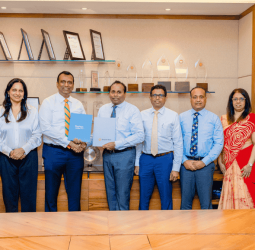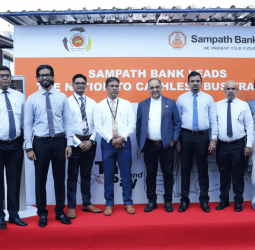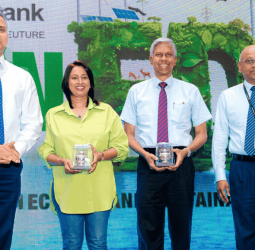Sampath Bank maintains its growth momentum in 2025, recording a 21% increase in profit after tax for the nine-month period
Financial Performance
Sampath Bank reported a Profit Before Tax (PBT) of Rs 35.3 Bn and a Profit After Tax (PAT) of Rs 21.5 Bn for the nine-month period ended 30th September 2025, reflecting consistent year-on-year growth of 18% and 21% respectively. Furthermore, the Group delivered a strong financial performance, recording a PBT of Rs 38.0 Bn and a PAT of Rs 23.1 Bn for the same period, marking growth of 19% and 21% respectively
Fund Based Income
The Bank’s total interest income declined by 3% year-on-year for the nine-month period ended 30th September 2025, reaching Rs 134.0 Bn. This decrease was primarily driven by the continued reduction in the Average Weighted Prime Lending Rate (AWPLR) and lower yields from government securities. Interest expenses saw a corresponding decrease of 2% year-on-year to Rs 76.8 Bn, reflecting the overall downward trend in market interest rates. Consequently, the Bank's Net Interest Income (NII) contracted by 6% year-on-year to Rs 57.2 Bn. The Net Interest Margin (NIM) narrowed by 81 basis points, from 4.90% as at 31st December 2024, to 4.09% as at 30th September 2025.
Non-Fund Based Income
The Bank reported a robust 107% year-on-year increase in total non-fund based income, reaching Rs 23.9 Bn for the nine-month period ended 30th September 2025.
Net fee and commission income, amounting to Rs 15.6 Bn, saw a robust 20% year-on-year growth, driven by strong performances in key business areas, including advances, cards, trade, operations, and electronic banking services.
The Bank also recorded a total exchange gain of Rs 3.5 Bn during the period, marking a notable turnaround from the exchange loss of Rs 3.5 Bn reported in the same period last year. This improvement was primarily driven by the depreciation of the LKR against the USD by Rs 9.30.
Impairment Charge
For the nine-month period ended 30th September 2025, the Bank recorded a total impairment charge of Rs 2.0 Bn, representing a significant decrease of 62% compared to the corresponding period in 2024. This comprised an impairment charge of Rs 2.3 Bn on loans and advances (2024: Rs 3.1 Bn), Rs 0.6 Bn on other financial assets (2024: Rs 1.2 Bn), and a reversal of Rs 0.8 Bn on credit-related commitments and contingencies (2024: charge of Rs 1.1 Bn).
Impairment charge on loans and advances and credit related commitments and contingencies
Notwithstanding a significant 18.9% expansion in the Bank’s loan portfolio during the period under review, impairment charges on loans and advances declined by 27% year-on-year. This reduction was largely attributable to improved credit quality and stronger repayment capacity across the customer base, supported by favorable macroeconomic conditions and an optimistic business outlook.
The Bank conducted a comprehensive assessment of its ISL customer portfolio, recognising tailored provisions in its Financial Statements to reflect the specific credit risk profiles of ISL customers. In line with its prudent risk management policy, the Bank continued to maintain sound collective impairment provisions, ensuring adequate buffers against potential future credit losses. Notably, the core models used for collective provisioning remained consistent with those applied in 2024.
The reversal of Rs 0.8 Bn (2024: charge of Rs 1.1 Bn) relating to credit-related commitments and contingencies reflects the overall improvement in the credit quality of the Bank’s customer base.
Impairment charge on other financial instruments
An impairment charge of Rs 0.6 Bn was recognised on other financial instruments during the reporting period, primarily attributable to newly acquired investments.
Operating Expenses
During the reporting period, the Bank’s operating expenses increased by 19% compared to the same period in 2024, primarily driven by higher personnel costs as a result of annual salary revisions as well as key strategic initiatives embarked upon by the Bank requiring an expansion of the Bank’s staff cadre and IT related costs. As expense growth continued to outpace the increase in operating income, the Bank’s cost-to-income ratio (CIR) deteriorated by 240 basis points, reaching 41.3%, compared to 38.9% in the corresponding period of the previous year.
Taxation
The total tax charge for the period increased to Rs 24.1 Bn, compared to Rs 20.9 Bn in the corresponding period of the previous year, primarily due to the rise in taxable income.
Key Ratios
As at 30th September 2025, the Bank reported a Return on Equity (after tax) of 17.24% and a Return on Average Assets (before tax) of 2.52%. These compare with 17.74% and 2.84%, respectively, as at 31st December 2024, reflecting a marginal decline in profitability ratios over the period.
Capital and Liquidity
Sampath Bank continued to demonstrate strong financial resilience during the period under review, maintaining capital adequacy well above the minimum regulatory requirements. As at 30th September 2025, the Bank’s Common Equity Tier 1 (CET 1), Tier 1, and Total Capital ratios stood at 14.06%, 14.06%, and 17.21%, respectively, compared to 16.75%, 16.75%, and 19.38% as at 31st December 2024. Following its designation as a Domestic Systemically Important Bank (D-SIB) by the Central Bank of Sri Lanka, effective 17th April 2025, the Bank became subject to an additional 1% capital buffer across all tiers. Despite this enhanced requirement, Sampath Bank comfortably maintained capital levels above the prescribed thresholds as at the reporting date.
Liquidity levels remained robust, with the All-Currency Liquidity Coverage Ratio (LCR) at 249.0% and the Net Stable Funding Ratio (NSFR) at 181.2%, compared to 307.4% and 198.7%, respectively, as at year-end 2024.
Assets
Sampath Bank’s total assets grew by 10% during the reporting period, reflecting an annualized growth rate of 13%. Total assets reached Rs 1.95 Tn as at 30th September 2025, up from Rs 1.78 Tn reported at the previous year-end. This growth was primarily driven by the expansion of the Bank’s loan portfolio.
The Bank’s gross loan portfolio, which surpassed the Rs 1 Tn milestone in 2025, reported a substantial increase of Rs 182 Bn, rising from Rs 964.6 Bn at the end of 2024 to Rs 1,147.0 Bn as at 30th September 2025. This growth was primarily driven by a Rs 163 Bn expansion in LKR-denominated loans, while FCY loans posted a modest increase of Rs 19 Bn during the period.
During the period, the Bank’s investment portfolio recorded a marginal decline, primarily reflecting the strategic reallocation of funds towards lending growth following the maturity of short-term investment securities. LKR-denominated Treasury bills decreased by Rs 55 Bn, while US Treasury bill holdings declined by Rs 44 Bn upon maturity. These reductions were partially offset by a Rs 41 Bn increase in LKR-denominated Treasury bonds, Rs 40 Bn in placements with other banks, and Rs 11 Bn in investments in Sri Lanka International Sovereign Bonds (PDIs).
The Sampath Group’s total assets exceeded Rs 2 Tn during the year, marking a 10% increase over the nine-month period.
Liabilities
As at 30th September 2025, Sampath Bank’s total liabilities rose to Rs 1.78 Tn, reflecting a 11% increase since year-end 2024 and an annualized growth rate of 14%. This growth was largely driven by a robust expansion in the Bank’s deposit base, which increased by Rs 137.6 Bn, from Rs 1,469.2 Bn at the end of 2024 to Rs 1,606.8 Bn. The increase was primarily fueled by LKR-denominated deposits, which contributed Rs 127.5 Bn, while foreign currency deposits rose by Rs 10.1 Bn.
The Bank’s CASA base strengthened by Rs 55.1 Bn during the period, resulting in an improvement in the CASA ratio to 34.5% as at 30th September 2025, up from 34.0% at the end of the previous year.
Commitment to Stakeholder Well-being
Sampath Bank continues to play an active role in supporting Sri Lanka’s economic recovery by assisting its customers in navigating financial challenges through the Business Revival Unit. This initiative provides advice and customized financial solutions to distressed businesses, enabling them to restructure, rebuild, and return to a growth trajectory. By enhancing customer creditworthiness and facilitating business continuity, the Bank has made a meaningful contribution in strengthening the financial stability and resilience of the SME and corporate sectors of the country.
Sampath Bank demonstrated strong ESG leadership through a diverse range of sustainability initiatives launched in celebration of World Environment Day 2025. Key efforts included the launch of a five-year project to conserve and promote the sustainable use of coral reefs and other coastal ecosystems within the Erumaitivu-Kakkativu seascape in Kilinochchi District, in partnership with IUCN (International Union for Conservation of Nature) Sri Lanka; the unveiling of the “Madhu Sampatha” floating market, aimed at reducing plastic pollution and supporting local artisans; and a mangrove restoration programme in Karamba, Puttlam to safeguard the oceanic ecosystems.
The Bank also continued its flagship “Wewata Jeewayak” irrigation tank restoration initiative and, in 2025, launched a women startup programme to promote inclusive economic development. ESG-linked credit screening mechanisms were further refined to align with global standards, strengthening governance and fostering sustainable value creation
In line with its commitment to climate transparency and responsible reporting, Sampath Bank is steadily aligning its ESG disclosures with globally recognised frameworks, including GRI, SLFRS S1 & S2, SASB, and the UN Global Compact. The Bank has also joined the Partnership for Carbon Accounting Financials (PCAF). Collectively, these initiatives have strengthened Sampath Bank’s position as a national ESG leader, earning it the title of “Best Bank for ESG in Sri Lanka” at the Euromoney Awards 2025.
You Must be Registered Or Logged in To Comment Log In?



 Natasha
Natasha






